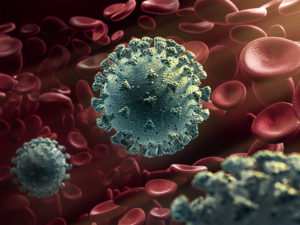Joining the dots between personalized and precision medicine by Dr. Debojyoti Chakraborty| CoronaCures Webinar Brief

“The test is named after a well-known Bengali fictional detective character created by the late Satyajit Ray.”
On July 4, the Coronacures team hosted Dr. Debojyoti Chakraborty as part of their webinar series. Dr. Chakraborty introduced us to India’s first COVID-19 paper strip test ‘FELUDA’ and the technology behind it. He is a senior scientist at CSIR-Institute of Genomics and Integrative Biology (IGIB) and heads an RNA Biology group. His lab is working on the development of efficient and specific tools for therapeutic genome editing, the systematic dissection of factors governing embryonic stem cell fate, and the use of cerebral organoids to address developmental questions such as the influence of DNA topology on transcription.
He is also the inventor of the CRISPR based COVID-19 diagnostic kit named FELUDA (FNCAS9 Editor-Linked Uniform Detection Assay). The test is named after a well-known Bengali fictional detective character created by the late Satyajit Ray. Using a combination of rational design of CRISPR Cas9 components and characterization of novel Cas9 orthologs, they have identified methods to increase the efficiency and specificity of this genome editing system.
India has seen a huge spike in the number of COVID-19 cases becoming the third worst-hit country in the world in recent times. Rapid testing and early detection of the infection could be the key to control the spread. The two diagnostics tests available are molecular tests and antibody-based serological tests. While the former can detect the presence of viral genetic material during early infection, the latter determines the antibody generated in the patients against the virus as an immune response. Antibodies can take about a week to develop hence serological tests which need blood sample are not very suitable for early detection.
The molecular tests which require oral or nasopharyngeal swabs are performed by large and specialized equipment like quantitative Real-time RT-PCR which may not be available in the remote parts of the country. The test relies on amplifying the complementary DNA generated from the viral RNA. The RNA sample could be contaminated with human RNA and the viral copy number may vary in the samples. To overcome some of these limitations, Dr. Chakraborthy has been able to repurpose the existing technologies in his lab to develop a diagnostic test prototype within a timeframe of a few months since COVID-19 breakout.
One of such technologies is CRISPR (Clustered Regularly Interspaced Short Palindromic Repeats). It is a precise, simple, and robust system that can be adapted to various applications. CRISPR based genome editing has been used to treat other disorders such as cancer, bloodborne diseases, cystic fibrosis, muscular dystrophy, and ocular disorders. Its first clinical trial started in 2019 in a sickle cell anemia patient has already been successful. It has also been proven safe in clinical trials to combat cancer.
How does the CRISPR system work?
The system has been adapted from bacteria that use a similar system against invading viruses as a defense mechanism. A short piece of RNA containing ‘guide’ RNA specific to the target DNA sequence of the genome is created in the lab. CAS9 (CRISPR associated protein9) enzyme attaches itself to the guide RNA bound to target DNA and cleaves the DNA into two parts. The scientists then rely on the cellular machinery to repair the cleaved DNA either by homology-directed repair (HDR) or non-homologous end joining (NHEJ). HDR is the more efficient and precise method but its occurrence in nature is rare. NHEJ can cause insertions and deletions in the desired DNA sequence. Scientists in the field are trying to increase the HDR rate using various chemical and biological modifications and reduce NHEJ. Off-targeting and double-stranded DNA breaks convolute gene editing for therapy. To prevent such off-target effects, Cas9 proteins can be engineered to make them more precise and robust.
Before the COVID-19 breakout, Dr. Chakraborty had already been working on CRISPR-Cas9 based precision genome editing in collaboration with Dr. Souvik Maiti (IGIB, New Delhi). As a proof of concept, they implemented it for therapeutic correction of sickle cell anemia mutation in Indian patient-derived stem cells. While working on the project they extensively characterized a Cas9 orthologue protein from bacteria Francisella novicida. They found that it is one of the largest Cas9 protein which works in an extremely specific manner and has less off-target effects. To enhance its efficacy, it was further engineered to generate FnCas9 protein.
To test the FnCas9 technology in clinical trials, Dr. Maiti and Dr. Chakraborty have collaborated with accomplished scientists across the globe. CSIR (Council of Scientific and Industrial Research, India) has developed a Mission Mode Project on Sickle Cell Anaemia which will allow the proof of concept studies of genome editing of sickle cell anemia.
Diagnosing disease with precision
CRISPRDx genome editing solutions have been used earlier for low-cost sequencing-free genotyping and diagnosing a disease (ex: Sherlock Biosciences, Mammoth Biosciences). FELUDA test was conceived to utilize the high specificity of FnCas9 (engineered Cas9) for a single mismatch accuracy based detection. ‘We were already detecting nucleic acid using FELUDA so we wondered if we could also detect viral nucleic acid’ says Dr. Chakraborty. The final kit will come with paper strips. Nasopharyngeal swab or saliva is collected from patients. RNA is extracted from the deactivated virus followed by a single-step RT-PCR (Reverse transcriptase-PCR). Purified RNA is reverse transcribed to cDNA and amplified by PCR using biotin-labeled primers.

The strip is submerged into the cDNA solution which moves up by lateral flow within 2-3 minutes. Positive SARS-Cov-2 patients’ amplicons are specifically detected by the FnCas9 complex present on the strip and give a signal below the control band at the streptavidin line. No signal indicates the sample is negative for SARS-Cov-2. The intensity of the test band in SARS-cov-2 positive samples is directly correlated with their viral load. The test can be performed within 1h and is very economical.
One test costs Rs500 which can be further brought down with indigenous manufacturing. Since it is a visual test, it can have an operator bias which can affect the results. To overcome this, an android app named TOPSE (True outcome predicted from strip evaluation) has been developed. The app clicks a picture of the strip and gives the outcome, also semi quantifying the viral load. Additionally, a webserver has been built called ‘’JATAYU’’ (Junction for analysis & target design for your FELUDA assay) which allows anyone to design guide RNA according to their experimental needs. The Satyajit Ray fans will know Topse and Jatayu are also fictional characters from the Feluda world.
The technology has been licensed to Tata Sons for commercialization. Dr. Chakraborty and his team are currently working towards developing a FELUDA test which can be easily done by anyone at home without any equipment.



